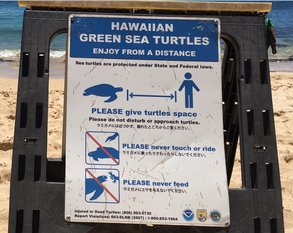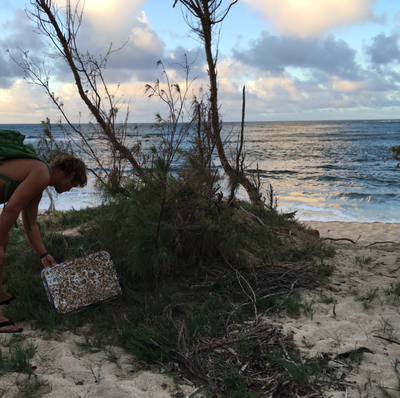|
Cleaning the beach on the North Shore of Oahu at Kahuku Point. Got to see the newly born baby Hawaiian Monk Seal and was glad to see signage up to keep people back. It is critical to do everything possible not to disturb these critically endangered animals under any circumstances!
0 Comments
 Yesterday, several HOA Ambassadors traveled up to the North Shore to visit Three Tables, Shark's Cove, and Kuilima Cove to compare signage regarding not stepping on, touching, or otherwise damaging the coral reefs; to take note of the agencies and civics groups responsible for placing and preserving each sign; to investigate signage at Laniakea regarding not touching sea turtles; and finally, to visit a nearby area where there are often Hawaiian monk seals to document any efforts at protection and education being made by volunteers or government on behalf of these highly endangered mammals. We began our day with a quick stop at Laniakea which is a perhaps the best beach in the world to see the 'threatened' green sea turtle, which frequently come ashore here at the south western end of the '7 Mile Miracle.' It is illegal to touch or otherwise disturb green sea turtles, and we were curious to see what kind of signage was in place to educate the throngs of visitors who stop here each day. We were impressed with the signage as it was centrally located and included not only words, but images to help instruct both English speaking and non-English speaking visitors as to the proper way to view these incredible animals. From there, the next stop was Three Tables which is located in Pupukea less than a mile north of world famous big wave surfing spot - Waimea Bay. Three Tables is part of the Pupukea Marine Life Conservation District which was established in 1983 and stretches from the Wananapaoa Islets at the southwestern end of Waimea Bay to Kulalua Point at the northern end of Shark's Cove. As a result of its official designation, this ocean area enjoys special protections against the removal of sand, rocks, corals, certain types of fishing, and limits on seaweed harvesting. Also, due to the efforts of the DLNR's Division of Aquatic Resources and Mālama Pūpūkea-Waimea - a volunteer-based NS nonprofit that was formed in 2005 as part of the State's Makai Watch program - this area has excellent signage regarding not damaging or disturbing the fragile coral reefs and marine ecosystem found in this jewel of a location. We went out for a brief swim and encountered beautiful corals, schools of Convict Tangs (Acanthurus tristegus), Parrotfish, Picasso Triggerfish, and even a honu ('honu' means green sea turtle in Hawaiian)! When encountering the honu on the Makai (or 'Ocean' side) of the blocks of coral (the 'tables' in 'Three Tables') we - like all who encounter these beautiful creatures - felt the pull to swim up to get a closer look, but fought back the urge, did the right thing, and kept our distance. We joyfully observed the turtle for several moments, snapped a photo, and swam off leaving her undisturbed. From there we headed several hundred yards up the coast to popular snorkel and dive site, Shark's Cove. We noted similar signs to the one pictured above along the entire stretch of coastline in this area and were thrilled to see no instances of visitors standing on or otherwise disturbing the reef environment (with the exception perhaps of the ocean's edge where those entering and exiting the water have to navigate a rocky and shallow shoreline.) We did some nice deep dives, holding our breaths as long as we could and marveling at this underwater paradise, before moving along to Kuilima Cove which is situated just to the east of the famed and only North Shore resort, Turtle Bay. We arrived at Turtle Bay and took some photos of the current signage at the beach. We knew from staying at the hotel recently that the signage is not up to par with the signage at the Marine Life Conservation area in Pupukea, as Kuilima Cove does not hold the same officially recognized status, government support, or special protections. That said, we'd love to see the hotel place signs regarding not touching or disturbing turtles, coral, or other marine life. All too often at this magical place do we see guests of the hotel and visitors to the beach resting their feet on the shallow coral bottom, standing up on the exposed coral blocks, and scrambling to take selfies up-close-and-personal with sea turtles. A little education goes a long way, and in this case, Turtle Bay Resort - which has a tremendous record of sustainable practices - ought to consider placing better signage to protect the reef that is such a valuable asset and resource to their guests, the environment, and the community at large. We've written two separate letters in the past week as a follow-up to our recent stay requesting a dialogue regarding updating the signage at Kuilima Cove, but as yet have not heard back. We are hopeful that we will hear something soon. We'd encourage others to reach out to TB as well regarding this issue as such an inexpensive update to the signs could go a long way towards protecting what was once one of Queen Liliuokalani's favorite swimming locales in the 1800s. You can contact the Turtle Bay Foundation at [email protected] to do your part to request new signage be erected to protect Kuilima Cove from reef damage caused by under-informed visitors. Pictures of the current signage are below. They are fairly standard for the signage you'd see elsewhere on the island, but they could be so much better! Compare these two signs to the ones pictured above from Lanikea, Three Tables, and Shark's Cove. In the ones currently at Kuilima Cove it is noted that there is a 'sharp coral bottom' which seems to warn swimmers of the dangers to the swimmers themselves of touching down, but not of the dangers to the coral reef. Given the medium-to-high number of turtle sightings in the cove, it would also be nice to see some additional signage regarding not touching the turtles as well. Well a guy can dream anyway, can't he...? Continuing down the beach we encountered a Hawaiian Monk Seal. These creatures are an extremely endangered species and must be given a very wide berth. Disturbing a monk seal through loud noises, coming too close for pictures, or any other form of harassment is not only illegal, it can also cause the monk seal to dangerously alter their feeding, mating, and resting cycles. There are only an estimated 1,100 Hawaiian monk seals left in existence, so please do all you can to avoid disturbing these amazing animals. You'll note in the pictures below that some conscientious volunteers erected a crude ring of vertical sticks to create a ring of protection against this resting monk seal, as well as some nearby signage aimed at educating passersby about the need to respect these ocean mammals. And finally, on the way back to the car we did our part to express our gratitude for this amazing day and this beautiful place by doing a mini beach clean-up, making sure to get AT LEAST THREE PIECES of trash before leaving for the day. Did you get your 3 pieces today??? Mahalo nui loa and much aloha! |
Archives
April 2020
Categories
All
|






















 RSS Feed
RSS Feed
